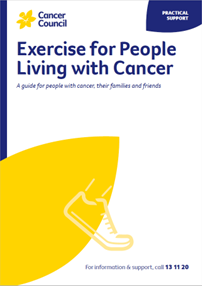- Home
- About Cancer
- Living well
- Exercise for people living with cancer (with videos)
- Strength and resistance (video)
- Upper body (video)
Upper body exercises
These exercises develop the muscles of your upper body, such as the muscles of your chest, shoulders and arms.
Watch videos on these exercises:
Standing wall push-up Modified push-up Standing row Shoulder press Upright row Biceps curlRemember to check with your health care team before starting any exercise program. Although we have provided strength training exercises to suit most people, some of them may not be right for you.
Standing wall push-up
Muscle group: Chest and shoulders
- Stand with your feet shoulder width apart. Lean slightly against the wall with your arms outstretched at shoulder height and your hands on the wall. Do not lock your elbows or knees.
- Slowly move your body towards the wall, by bending your arms at the elbow. Keep you feet where they are.
- Once your nose is close to the wall, breathe out as you slowly push away, against your body weight, and return to the starting position. Repeat.
⇑ If this is too easy, move your feet back a bit or try a modified knee push-up (see below).
Modified knee push-up
Muscle group: Chest, shoulders and arms
- Start with your knees and hands on the floor and your arms extended. Keep your back and bottom as straight as possible, and keep your head in line with your spine.
- Lower your torso slowly, by bending your arms at the elbow. Aim to keep your chest moving straight towards the floor (not forwards or backwards). Only go as far down as you feel you can.
- Breathe out as you push back up to the starting position, and try not to fully straighten your arms and lock your elbows at the top. Repeat.
If you feel any pain in your back doing this exercise, bring your hands closer to your body. If this still feels hard, do the wall push-up until you build more strength.
Standing row
Muscle group: Shoulders, back, and back of upper arms
Equipment: Elastic resistance band
- Attach the resistance band to a fixed point such as a railing, pole or a closed door handle, ensuring it’s well secured. Stand with your feet shoulder width apart and your arms outstretched at waist height.
- Breathe out as you pull the resistance band towards you, keeping your elbows and hands at waist height. Make sure your back doesn’t move, and look straight ahead. Keep neck and shoulders relaxed to avoid your shoulders lifting up.
- Slowly and with control return to the starting position. Repeat.
Shoulder press
Muscle group: Shoulders
Equipment: Gym stick, barbell, pole, broomstick, tin cans or hand weights
- Stand with your feet shoulder width apart. Hold the bar at chest height with your elbows almost completely bent (so they are almost touching your sides).
- Breathe out as you push the bar up until it is above and slightly in front of your head. Keep your back and neck straight and don’t lift your shoulders.
- Pause, then lower the bar back to the starting position. Repeat.
⇑ Increase the difficulty by adding weight to the bar or increasing your hand weights.
Upright row
Muscle group: Shoulders and upper back
Equipment: Hand weights, tin cans
- Stand with your arms by your side and your feet shoulder width apart. Hold the hand weights with your palms facing backwards. Tighten the tummy muscles (abdominals).
- Breathe out as you bend your arms and raise the hand weights slowly up to shoulder height. Avoid jerking the weights when lifting them up. Keep your head and neck aligned, and look straight ahead. Avoid lifting your shoulders to your ears. You should feel the muscles in your shoulders work, not the ones in your neck.
- Pause, then lower the hand weights back to the starting position. Repeat.
⇑ Use lighter weights to start with and increase as your strength and fitness improve.
Biceps curl
Muscle group: Front of upper arms
Equipment: Hand weights, gym stick, barbell or tin cans
- Stand with your arms by your side and feet hip width apart. Hold the hand weights with your palms pointing away from you.
- Breathe out as you bend your elbows to lift the weights to shoulder height. Keep your elbows tucked in at the sides. Try not to move your shoulders and make sure your body does not sway.
- Slowly return the hand weights almost to the starting position without fully straightening your elbows – keep them slightly bent. Repeat.
⇑ Use lighter weights to start with and increase as your strength and fitness improve.
More resources
Kirsten Adlard, Accredited Exercise Physiologist, The University of Queensland, QLD; Dr Diana Adams, Medical Oncologist, Macarthur Cancer Therapy Centre, NSW; Grace Butson, Senior Physiotherapist, Peter MacCallum Cancer Centre, VIC; Kate Cox, 13 11 20 Consultant, Cancer Council SA; Wai Yin Chung, Consumer; Thomas Harris, Men’s Health Physiotherapist, QLD; Clare Hughes, Chair of Cancer Council’s Nutrition, Alcohol and Physical Activity Committee; Jen McKenzie, Level 1 Lymphoedema Physiotherapist, ESSA Accredited Exercise Physiologist, The McKenzie Clinic, QLD; Claudia Marck, Consumer; Dr David Mizrahi, Accredited Exercise Physiologist and Research Fellow, The Daffodil Centre at Cancer Council NSW and The University of Sydney, NSW; Prof Rob Newton, Professor of Exercise Medicine, Exercise Medicine Research Institute, Edith Cowan University, WA; Jason Sonneman, Consumer.
View the Cancer Council NSW editorial policy.
View all publications or call 13 11 20 for free printed copies.

